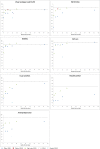Health related quality of life in adults after burn injuries: A systematic review
- PMID: 29795616
- PMCID: PMC5967732
- DOI: 10.1371/journal.pone.0197507
Health related quality of life in adults after burn injuries: A systematic review
Abstract
Objectives: Measurement of health-related quality of life (HRQL) is essential to qualify the subjective burden of burns in survivors. We performed a systematic review of HRQL studies in adult burn patients to evaluate study design, instruments used, methodological quality, and recovery patterns.
Methods: A systematic review was performed. Relevant databases were searched from the earliest record until October 2016. Studies examining HRQL in adults after burn injuries were included. Risk of bias was scored using the Quality in Prognostic Studies tool.
Results: Twenty different HRQL instruments were used among the 94 included studies. The Burn Specific Health Scale-Brief (BSHS-B) (46%), the Short Form-36 (SF-36) (42%) and the EuroQol questionnaire (EQ-5D) (9%) were most often applied. Most domains, both mentally and physically orientated, were affected shortly after burns but improved over time. The lowest scores were reported for the domains 'work' and 'heat sensitivity' (BSHS-B), 'bodily pain', 'physical role limitations' (SF-36), and 'pain/discomfort' (EQ-5D) in the short-term and for 'work' and 'heat sensitivity', 'emotional functioning' (SF-36), 'physical functioning' and 'pain/discomfort' in the long-term. Risk of bias was generally low in outcome measurement and high in study attrition.
Conclusion: Consensus on preferred validated methodologies of HRQL measurement in burn patients would facilitate comparability across studies, resulting in improved insights in recovery patterns and better estimates of HRQL after burns. We recommend to develop a guideline on the measurement of HRQL in burns. Five domains representing a variety of topics had low scores in the long-term and require special attention in the aftermath of burns.
Conflict of interest statement
The authors have declared that no competing interests exist.
Figures








Similar articles
-
Yoga for chronic non-specific low back pain.Cochrane Database Syst Rev. 2022 Nov 18;11(11):CD010671. doi: 10.1002/14651858.CD010671.pub3. Cochrane Database Syst Rev. 2022. PMID: 36398843 Free PMC article.
-
Chronic non-invasive ventilation for chronic obstructive pulmonary disease.Cochrane Database Syst Rev. 2021 Aug 9;8(8):CD002878. doi: 10.1002/14651858.CD002878.pub3. Cochrane Database Syst Rev. 2021. PMID: 34368950 Free PMC article.
-
Saline irrigation for allergic rhinitis.Cochrane Database Syst Rev. 2018 Jun 22;6(6):CD012597. doi: 10.1002/14651858.CD012597.pub2. Cochrane Database Syst Rev. 2018. PMID: 29932206 Free PMC article.
-
Exercise interventions and patient beliefs for people with hip, knee or hip and knee osteoarthritis: a mixed methods review.Cochrane Database Syst Rev. 2018 Apr 17;4(4):CD010842. doi: 10.1002/14651858.CD010842.pub2. Cochrane Database Syst Rev. 2018. PMID: 29664187 Free PMC article.
-
Eliciting adverse effects data from participants in clinical trials.Cochrane Database Syst Rev. 2018 Jan 16;1(1):MR000039. doi: 10.1002/14651858.MR000039.pub2. Cochrane Database Syst Rev. 2018. PMID: 29372930 Free PMC article.
Cited by
-
The Application of a Synthetic Biodegradable Temporizing Matrix in Extensive Burn Injury: A Unicenter Experience of 175 Cases.J Clin Med. 2024 May 1;13(9):2661. doi: 10.3390/jcm13092661. J Clin Med. 2024. PMID: 38731190 Free PMC article.
-
Burn injury characteristics, referral pattern, treatment (costs), and outcome in burn patients admitted to a hospital with or without a specialized Burn Centre (BURN-Pro).Eur J Trauma Emerg Surg. 2023 Jun;49(3):1505-1515. doi: 10.1007/s00068-023-02233-9. Epub 2023 Feb 3. Eur J Trauma Emerg Surg. 2023. PMID: 36735021 Free PMC article.
-
Physical and Psychosocial Concept Domains Related to Health-Related Quality of Life (HRQL) in 50 Girls and 52 Boys Between 5 and 18 Years Old in Poland Using the Parent-Reported 50-Item Child Health Questionnaire (CHQ-PF50).Med Sci Monit. 2022 Jun 9;28:e936801. doi: 10.12659/MSM.936801. Med Sci Monit. 2022. PMID: 35676835 Free PMC article.
-
Scar Assessment Tools: How Do They Compare?Front Surg. 2021 Jun 23;8:643098. doi: 10.3389/fsurg.2021.643098. eCollection 2021. Front Surg. 2021. PMID: 34250003 Free PMC article. Review.
-
Trauma system management of adults with severe burns in Victoria, Australia.Emerg Med Australas. 2025 Feb;37(1):e14495. doi: 10.1111/1742-6723.14495. Epub 2024 Sep 11. Emerg Med Australas. 2025. PMID: 39261992 Free PMC article.
References
-
- Brusselaers N, Hoste EAJ, Monstrey S, Colpaert KE, De Waele JJ, Vandewoude KH, et al. Outcome and changes over time in survival following severe burns from 1985 to 2004. Intensive Care Med. 2005;31(12):1648–53. doi: 10.1007/s00134-005-2819-6 - DOI - PubMed
-
- Bloemsma GC, Dokter J, Boxma H, Oen I. Mortality and causes of death in a burn centre. Burns. 2008;34(8):1103–7. doi: 10.1016/j.burns.2008.02.010 - DOI - PubMed
-
- Falder S, Browne A, Edgar D, Staples E, Fong J, Rea S, et al. Core outcomes for adult burn survivors: a clinical overview. Burns. 2009;35(5):618–41. doi: 10.1016/j.burns.2008.09.002 - DOI - PubMed
-
- Jasper S, Rennekampff H-O, de Zwaan M. Psychiatric co-morbidity, body image problems and psychotherapeutic interventions for burn survivors: a review. Psychother Psychosom Med Psychol. 2013;63(11):423–8. doi: 10.1055/s-0033-1343463 - DOI - PubMed
-
- Van Baar M, Essink-Bot M-L, Oen I, Dokter J, Boxma H, van Beeck EF. Functional outcome after burns: a review. Burns. 2006;32(1):1–9. doi: 10.1016/j.burns.2005.08.007 - DOI - PubMed
Publication types
MeSH terms
LinkOut - more resources
Full Text Sources
Other Literature Sources
Medical

